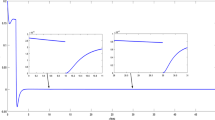Abstract
This paper discusses the input-to-state stability (ISS) of continuous-time impulsive switched nonlinear systems. Based on a novel approach called edge-dependent average dwell time (EDADT), some sufficient conditions are presented to guarantee the ISS of the considered systems containing both ISS and non-ISS subsystems by utilizing Lyapunov functions. It is also shown that when all subsystems are ISS, the systems are ISS under the EDADT scheme even though the switching instants are destabilizing. Conversely, when all subsystems are non-ISS, the designed fast EDADT scheme coupled with stabilizing switchings is sufficient for ISS of the systems. Some generalizations are made compared with the previous ones, which are also illustrated by numerical examples.






Similar content being viewed by others
References
Z. Ai, L. Peng, Stabilization and robustness analysis of multi-module impulsive switched linear systems. Nonlinear Anal. Hybrid Syst. 30, 293–305 (2018)
S. Dashkovskiy, B. Rüffer, F. Wirth, Small gain theorems for large scale systems and construction of ISS Lyapunov functions. SIAM J. Control. Optim. 48, 4089–4118 (2010)
Z. Dong, X. Wang, X. Zhang, A nonsingular M-matrix-based global exponential stability analysis of higher-order delayed discrete-time Cohen–Grossberg neural networks. Appl. Math. Comput. 385, 125401 (2020)
L. Gao, Z. Cao, M. Zhang, Q. Zhu, Input-to-state stability for hybrid delayed systems with admissible edge-dependent switching signals. J. Frankl. Inst. 357(13), 8823–8850 (2020)
F. Grognard, Feedback stabilization of predator-prey systems for impulsive biological control. IFAC Proc. 47, 5264–5269 (2014)
C. Guan, Z. Fei, Z. Wang, L. Wu, Stabilisation of continuous-time switched 2D systems with all unstable modes. IET Control Theory Appl. 12(6), 793–801 (2018)
G. Han, Z. Guan, J. Li, R. Liao, X. Cheng, Multi-consensus of multi-agent networks via a rectangular impulsive approach. Syst. Control Lett. 76, 28–34 (2015)
J.P. Hespanha, A.S. Morse, Stability of switched systems with average dwell-time, in Proceedings of the 38th IEEE Conference on Decision and Control (1999), pp. 2655–2660
C. Huang, F. Wang, Z. Zheng, Exponential stability for nonlinear fractional order sampled-data control systems with its applications. Chaos Solitons Fract. 151, 111265 (2021)
M. Krichman, E.D. Sontag, Y. Wang, Input-output-to-state stability. SIAM J. Control. Optim. 39, 1874–1928 (2000)
Z. Lei, H. Ding, X. Xiao, Input-to-state stability of discrete-time switched nonlinear systems with generalized switching signals. Appl. Math. Comput. 392, 125727 (2021)
X. Li, P. Li, Q. Wang, Input/output-to-state stability of impulsive switched systems. Syst. Control Lett. 116, 1–7 (2018)
D. Liberzon, Switching in Systems and Control. Systems and Control: Foundations and Applications (Birkhäuser, Boston, 2003)
A.S. Morse, Supervisory control of families of linear set-point controllers—part I: exact matching. IEEE Trans. Autom. Control 41, 1413–1431 (1996)
M.A. Müller, D. Liberzon, Input/output-to-state stability and state-norm estimators for switched nonlinear systems. Automatica 48, 2029–2039 (2012)
H. Ren, G. Zong, L. Hou, Finite-time control of interconnected impulsive switched systems with time-varying delay. Appl. Math. Comput. 276, 198–226 (2016)
E.D. Sontag, Y. Wang, On characterizations of the input-to-state stability property. Syst. Control Lett. 24(5), 351–359 (1995)
I. Stamova, T. Stamov, X. Li, Global exponential stability of a class of impulsive cellular neural networks with supremums. Int. J. Adapt. Control Signal Process 28, 1227–1239 (2014)
E. Verriest, Regularization method for optimally switched and impulsive systems with biomedical applications, in Proceedings of the 43th IEEE Conference on Decision and Control (2003), pp. 2156–2161
Z. Wang, P. Shi, C. Lim, \(H_{-}\)/\(H_{\infty }\) fault detection observer in finite frequency domain for linear parameter-varying descriptor systems. Automatica 86, 28–45 (2017)
W. Xiang, J. Xiao, Stabilization of switched continuous-time systems with all modes unstable via dwell time switching. Automatica 50, 940–945 (2014)
J. Xu, J. Sun, Finite-time stability of nonlinear switched impulsive systems. Int. J. Syst. Sci. 44(5), 889–895 (2013)
J. Yang, X. Zhao, X. Bu, W. Qian, Stabilization of switched linear systems via admissible edge-dependent switching signals. Nonlinear Anal. Hybrid Syst. 62, 100–109 (2018)
X. Zhang, X. Lv, X. Li, Sampled-data based lag synchronization of chaotic delayed neural networks with impulsive control. Nonlinear Dyn. 90, 2199–2207 (2017)
X. Zhao, L. Zhang, P. Shi, M. Liu, Stability and stabilization of switched linear systems with mode-dependent average dwell time. IEEE Trans. Autom. Control 57(7), 1809–1815 (2012)
Acknowledgements
This work was supported by the National Natural Science Foundation of China under Grant 11861027.
Author information
Authors and Affiliations
Corresponding author
Ethics declarations
Conflict of interest
The authors declare that they have no conflicts of interest.
Data Availability
All data included in this study are available upon request by contact with the corresponding author.
Additional information
Publisher's Note
Springer Nature remains neutral with regard to jurisdictional claims in published maps and institutional affiliations.
Rights and permissions
About this article
Cite this article
Pan, S., Shao, Y. A Novel Approach to Input-to-State Stability of Impulsive Switched Nonlinear Systems. Circuits Syst Signal Process 41, 3739–3754 (2022). https://doi.org/10.1007/s00034-022-01954-3
Received:
Revised:
Accepted:
Published:
Issue Date:
DOI: https://doi.org/10.1007/s00034-022-01954-3




